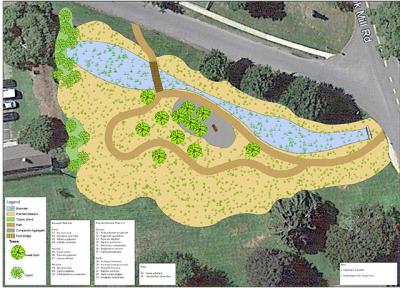Planning a ‘Meadow’ on Methodist Lane

A preliminary plan to turn East Hampton Village property on Methodist Lane into a bioswale, a drainage system designed to reduce pollution from surface runoff water, was presented to the village board last Thursday. The board also discussed a separate project to rid Town Pond of accumulated sediment.
Tony Piazza of the Piazza Horticultural Group in Southampton, who designed the bioswale installed near Town Pond in 2016, told the board that the Methodist Lane project‚ done in partnership with the Surfrider Foundation and the Ladies Village Improvement Society‚ would be broader in scope. The plan includes a meadow containing grasses, plants, and trees native to Long Island. “We’d be creating a complete ecosystem that could be used for educational purposes,” Mr. Piazza said.
A footbridge would cross the bioswale, and in the meadow there would be pathways made from a compacted aggregate of stone and stone dust, which would create, he said, a “dense, water-permeable surface that doesn’t grow weeds and is completely safe to walk on.”
Both the bridge and the pathways would be six feet wide to accommodate two people walking side by side. There would also be a bench, for visitors to sit and take in the view.
“It certainly is inviting,” said Mayor Paul F. Rickenbach Jr., who asked that the plan be made compliant with Americans With Disabilities Act regulations.
The project would be funded by private donations. Anne Thomas, president of the L.V.I.S., said she had received numerous requests from residents looking for ways to memorialize Ben and Bonnie Krupinski, the East Hampton business owners and philanthropists who died in a plane crash in June. “Water quality was a priority for Bonnie,” said Ms. Thomas. The L.V.I.S., she added, “would be prepared to embellish on those offers and go farther if we needed to. We’re there to help.”
Stephen Mahoney, a member of the Surfrider Foundation, which works to protect oceans and beaches, said that his group also had funds in hand and that there was “communitywide interest in this.”
In a separate measure designed to improve the village’s water quality, Drew Bennett, a consulting engineer, put forward a proposal to remove scores of years of siltation from Town Pond. Following a study of the pond, he said, it is estimated that the pond bottom contains 10,000 cubic yards of sediment.
Proposals to do the work will be requested from contractors, who will determine the means of removing and disposing of the material. There are two methods seen as practical, Mr. Bennett said. One is to dry out the pond to expose the sediment, and then mechanically remove it. The other is to use hydraulic suction to pump the debris into geobags.
The process would involve two phases, starting with the removal of 1,000 cubic yards of debris from the southern end of the pond as a test case, and then tackling the rest of the job.
Contractors will have to spell out in their bids how they would dispose of or re-use the material. A permit from the state’s Department of Environmental Conservation for the work, as well as the disposal or re-use, will be needed.
The timeline would be a few months, though the permitting process can add an additional three to six months, the engineer said. “Obviously, we’d like to do it in the winter,” he said, and since the coming one was not realistic, he recommended that work begin in 2019.
